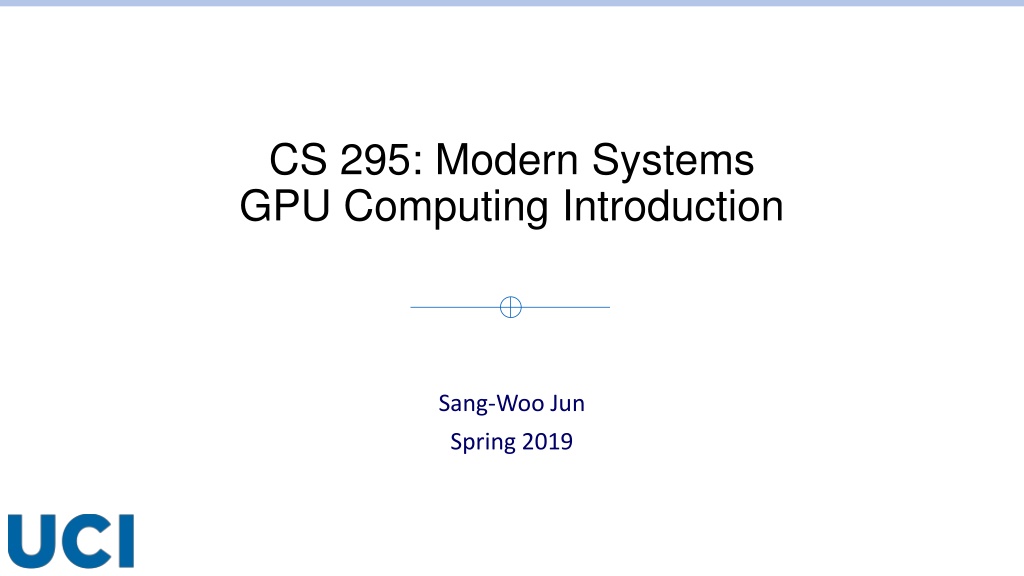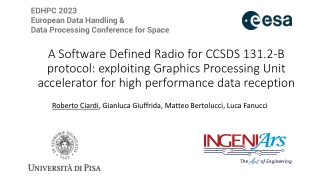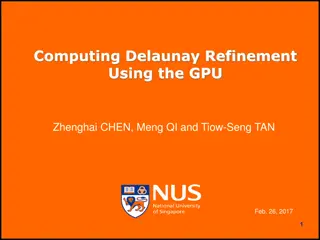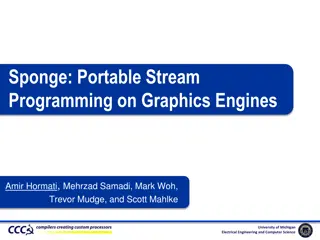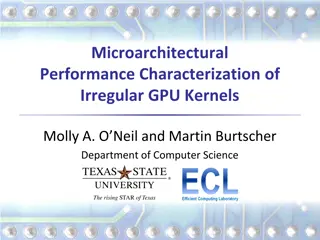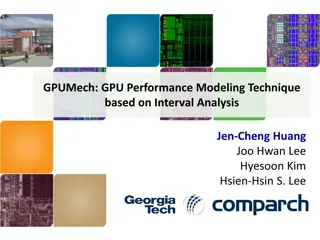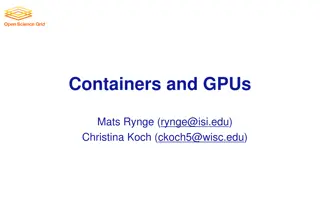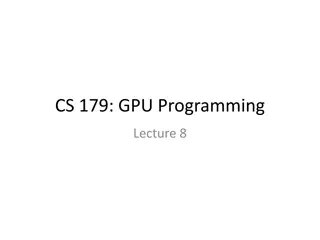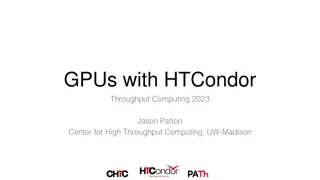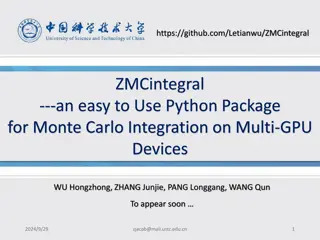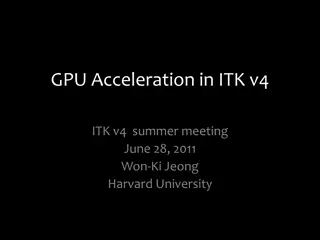Understanding Modern GPU Computing: A Historical Overview
Delve into the fascinating history of Graphic Processing Units (GPUs), from the era of CPU-dominated graphics computation to the introduction of 3D accelerator cards, and the evolution of GPU architectures like NVIDIA Volta-based GV100. Explore the peak performance comparison between CPUs and GPUs, highlighting the significant performance gains and efficiencies offered by GPU processing power.
Download Presentation

Please find below an Image/Link to download the presentation.
The content on the website is provided AS IS for your information and personal use only. It may not be sold, licensed, or shared on other websites without obtaining consent from the author. Download presentation by click this link. If you encounter any issues during the download, it is possible that the publisher has removed the file from their server.
E N D
Presentation Transcript
CS 295: Modern Systems GPU Computing Introduction Sang-Woo Jun Spring 2019
Graphic Processing Some History 1990s: Real-time 3D rendering for video games were becoming common o Doom, Quake, Descent, (Nostalgia!) 3D graphics processing is immensely computation-intensive Texture mapping Shading Warren Moore, Textures and Samplers in Metal, Metal by Example, 2014 Gray Olsen, CSE 470 Assignment 3 Part 2 - Gourad/Phong Shading, grayolsen.com, 2018
Graphic Processing Some History Before 3D accelerators (GPUs) were common CPUs had to do all graphics computation, while maintaining framerate! o Many tricks were played Doom (1993) : Affine texture mapping Linearly maps textures to screen location, disregarding depth Doom levels did not have slanted walls or ramps, to hide this
Graphic Processing Some History Before 3D accelerators (GPUs) were common CPUs had to do all graphics computation, while maintaining framerate! o Many tricks were played Quake III arena (1999) : Fast inverse square root magic!
Introduction of 3D Accelerator Cards Much of 3D processing is short algorithms repeated on a lot of data o pixels, polygons, textures, Dedicated accelerators with simple, massively parallel computation A Diamond Monster 3D, using the Voodoo chipset (1997) (Konstantin Lanzet, Wikipedia)
NVIDIA Volta-based GV100 Architecture (2018) Many many cores, not a lot of cache/control
Peak Performance vs. CPU Throughput Power Throughput/Power Intel Skylake 128 SP GFLOPS/4 Cores 100+ Watts ~1 GFLOPS/Watt NVIDIA V100 15 TFLOPS 200+ Watts ~75 GFLOPS/Watt Also,
System Architecture Snapshot With a GPU (2019) GPU Memory (GDDR5, HBM2, ) GDDR5: 100s GB/s, 10s of GB HBM2: ~1 TB/s, 10s of GB GPU NVMe CPU I/O Hub (IOH) DDR4 2666 MHz 128 GB/s 100s of GB Network Interface QPI/UPI 12.8 GB/s (QPI) 20.8 GB/s (UPI) PCIe 16-lane PCIe Gen3: 16 GB/s Host Memory (DDR4, ) Lots of moving parts!
High-Performance Graphics Memory Modern GPUs even employing 3D-stacked memory via silicon interposer o Very wide bus, very high bandwidth o e.g., HBM2 in Volta Graphics Card Hub, GDDR5 vs GDDR5X vs HBM vs HBM2 vs GDDR6 Memory Comparison, 2019
Massively Parallel Architecture For Massively Parallel Workloads! NVIDIA CUDA (Compute Uniform Device Architecture) 2007 o A way to run custom programs on the massively parallel architecture! OpenCL specification released 2008 Both platforms expose synchronous execution of a massive number of threads GPU Threads GPU Thread Copy over PCIe Copy over PCIe CPU
CUDA Execution Abstraction Block: Multi-dimensional array of threads o 1D, 2D, or 3D o Threads in a block can synchronize among themselves o Threads in a block can access shared memory o CUDA (Thread, Block) ~= OpenCL (Work item, Work group) Grid: Multi-dimensional array of blocks o 1D or 2D o Blocks in a grid can run in parallel, or sequentially Kernel execution issued in grid units Limited recursion (depth limit of 24 as of now)
Simple CUDA Example Asynchronous call GPU side CPU side C/C++ + CUDA Code Host Compiler NVCC Compiler CPU+GPU Software Device Compiler
Simple CUDA Example 1 block __global__: __device__: __host__: N threads per block In GPU, called from host/GPU In GPU, called from GPU Should wait for kernel to finish In host, called from host N instances of VecAdd spawned in GPU One function can be both Which of N threads am I? See also: blockIdx Only void allowed
More Complex Example: Picture Blurring Slides from NVIDIA/UIUC Accelerated Computing Teaching Kit Another end-to-end example https://devblogs.nvidia.com/even-easier-introduction-cuda/ Great! Now we know how to use GPUs Bye?
Matrix Multiplication Performance Engineering No faster than CPU Results from NVIDIA P100 Architecture knowledge is needed (again) Coleman et. al., Efficient CUDA, 2017
NVIDIA Volta-based GV100 Architecture (2018) Single Streaming Multiprocessor (SM) has 64 INT32 cores and 64 FP32 cores (+8 Tensor cores ) GV100 has 84 SMs
Volta Execution Architecture 64 INT32 Cores, 64 FP32 Cores, 4 Tensor Cores, Ray- tracing cores.. o Specialization to make use of chip space ? Not much on-chip memory per thread o 96 KB Shared memory o 1024 Registers per FP32 core Hard limit on compute management o 32 blocks AND 2048 threads AND 1024 threads/block o e.g., 2 blocks with 1024 threads, or 4 blocks with 512 threads o Enough registers/shared memory for all threads must be available (all context is resident during execution) More threads than cores Threads interleaved to hide memory latency
Resource Balancing Details How many threads in a block? Too small: 4x4 window == 16 threads o 128 blocks to fill 2048 thread/SM o SM only supports 32 blocks -> only 512 threads used SM has only 64 cores does it matter? Sometimes! Too large: 32x48 window == 1536 threads o Threads do not fit in a block! Too large: 1024 threads using more than 64 registers Limitations vary across platforms (Fermi, Pascal, Volta, )
Warp Scheduling Unit Threads in a block are executed in 32-thread warp unit o Not part of language specs, just architecture specifics o A warp is SIMD Same PC, same instructions executed on every core What happens when there is a conditional statement? o Prefix operations, or control divergence o More on this later! Warps have been 32-threads so far, but may change in the future
Memory Architecture Caveats Shared memory peculiarities o Small amount (e.g., 96 KB/SM for Volta) shared across all threads o Organized into banks to distribute access o Bank conflicts can drastically lower performance Relatively slow global memory o Blocking, caching becomes important (again) o If not for performance, for power consumption 8-way bank conflict 1/8 memory bandwidth
